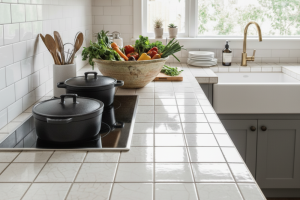 Ceramic tile countertops have emerged as a popular choice for homeowners looking to combine style, functionality, and affordability in their kitchen or bathroom spaces. With a rich history dating back over a century, these surfaces have evolved significantly, offering a wide array of designs and materials that cater to modern aesthetics. In this comprehensive guide, we will explore the various aspects of ceramic tile countertops, including their advantages, disadvantages, maintenance, installation tips, and design possibilities.
Ceramic tile countertops have emerged as a popular choice for homeowners looking to combine style, functionality, and affordability in their kitchen or bathroom spaces. With a rich history dating back over a century, these surfaces have evolved significantly, offering a wide array of designs and materials that cater to modern aesthetics. In this comprehensive guide, we will explore the various aspects of ceramic tile countertops, including their advantages, disadvantages, maintenance, installation tips, and design possibilities.
Understanding Ceramic Tile Countertops
Ceramic tile countertops are made from clay that is fired at high temperatures, resulting in a durable and versatile surface. These countertops can be found in various formats, including traditional small tiles and larger slabs, allowing for a range of design options. The adaptability of ceramic tiles makes them suitable for various styles, from rustic to contemporary.
Types of Ceramic Tiles
- Traditional Ceramic Tiles: These are smaller tiles, often measuring 4×4 inches or 12×12 inches, and are available in a multitude of colors and patterns. They allow for creative layouts and designs, making them a favorite among DIY enthusiasts.
- Large-Format Tiles: These tiles are larger than traditional ones, typically measuring 6×3 feet or more. They provide a seamless look, reducing the visibility of grout lines and making maintenance easier.
- Porcelain Tiles: A subtype of ceramic, porcelain tiles are denser and less porous, making them more durable and resistant to moisture. They are ideal for high-traffic areas and can mimic the appearance of natural stone.
Advantages of Ceramic Tile Countertops
Ceramic tile countertops come with a host of benefits that make them an attractive option for many homeowners.
Affordability
One of the most significant advantages of ceramic tile countertops is their cost-effectiveness. Prices can range from $1 to $15 per square foot, depending on the type and quality of the tile. This affordability makes them accessible for various budgets, especially when compared to more expensive materials like granite or quartz.
Design Versatility
Ceramic tiles offer endless design possibilities. Homeowners can choose from a wide array of colors, patterns, and finishes, allowing for a customized look that can complement any kitchen or bathroom decor. Whether you prefer a classic white subway tile or a bold, patterned design, ceramic tiles can cater to your aesthetic preferences.
Durability
Ceramic tiles are known for their durability. They are resistant to scratches, stains, and heat, making them suitable for busy kitchens. You can place hot pots and pans directly on the surface without worrying about damage. Additionally, if a tile becomes chipped or cracked, it can often be replaced individually, saving you the cost of replacing the entire countertop.
Easy Maintenance
Maintaining ceramic tile countertops is relatively straightforward. Regular cleaning with mild soap and water is usually sufficient to keep them looking fresh. Unlike some materials that require frequent sealing, ceramic tiles are non-porous, which helps prevent bacteria growth and makes them a hygienic choice for food preparation areas.
Considerations For Ceramic Tile Countertops
While ceramic tile countertops have many advantages, they also come with some drawbacks that homeowners should consider.
Grout Lines
One of the most significant downsides of ceramic tile countertops is the presence of grout lines. These lines can accumulate dirt and stains over time, making them more challenging to clean than solid surfaces. Regular sealing of the grout is necessary to maintain its appearance and prevent mildew growth.
Chipping and Cracking
Although ceramic tiles are durable, they can chip or crack if heavy objects are dropped on them. While individual tiles can be replaced, finding an exact match for a damaged tile can sometimes be difficult, especially if the tiles are no longer in production.
Uneven Surface
Depending on the size of the tiles and the width of the grout lines, ceramic tile countertops may not provide a perfectly smooth surface. This can be a minor inconvenience for tasks like rolling dough or chopping ingredients.
Installation of Ceramic Tile Countertops
Installing ceramic tile countertops can be a rewarding DIY project, but it requires careful planning and execution to achieve a professional finish.
Preparation
Before installation, ensure that the substrate is suitable for tile. A cement backer board is recommended over plywood, as it provides a stable and moisture-resistant base.
Layout Planning
Creating a dry layout of the tiles before applying adhesive is crucial. This allows you to visualize the final design and make any necessary adjustments. Use tile spacers to ensure uniform gaps between tiles.
Adhesive and Grouting
Choose the appropriate adhesive based on the type of tile you are using. For example, porcelain tiles require a specific adhesive designed for their density. After the tiles are set and the adhesive has cured, apply grout to fill the gaps.
Sealing
Once the grout has dried, it’s essential to seal it to protect against stains and moisture. Regular maintenance of the grout lines will help keep your countertops looking their best.
Maintenance Tips for Ceramic Tile Countertops
To ensure the longevity and appearance of your ceramic tile countertops, follow these maintenance tips:
Daily Cleaning
Wipe down the surface with a damp cloth and mild dish soap to remove spills and stains. Avoid using abrasive cleaners that can scratch the tile surface.
Grout Care
Regularly inspect the grout lines for signs of staining or mildew. Clean them with a mixture of baking soda and water or a commercial grout cleaner. Sealing the grout at least once a year will help maintain its integrity.
Addressing Stains
For stubborn stains, create a paste using baking soda and water. Apply it to the stained area, let it sit for 10-15 minutes, and then scrub gently with a soft brush.
Design Ideas for Ceramic Tile Countertops
Ceramic tile countertops can enhance the aesthetic appeal of your kitchen or bathroom. Here are some design ideas to inspire your project:
Bold Patterns
Consider using colorful, patterned tiles to create a statement countertop. Mixing different tile shapes and sizes can add visual interest and personality to your space.
Monochromatic Schemes
For a sleek and modern look, opt for a monochromatic color scheme. White or gray tiles can create a clean and timeless appearance that complements various design styles.
Textured Finishes
Incorporate textured tiles to add depth and dimension to your countertops. Textured surfaces can create a tactile experience and enhance the overall design.
Comparing Ceramic Tile to Other Countertop Materials
When considering countertop options, it’s essential to compare ceramic tile with other materials to determine the best fit for your needs.
Ceramic Tile vs. Granite
Granite countertops are known for their durability and natural beauty, but they come at a higher price point. While granite is less prone to chipping, it requires regular sealing to maintain its appearance. Ceramic tiles, on the other hand, offer a more budget-friendly option with a wide range of design possibilities.
Ceramic Tile vs. Quartz
Quartz countertops are engineered stone surfaces that provide a non-porous, uniform appearance. While they are more expensive than ceramic tiles, they require less maintenance and are less prone to staining. However, ceramic tiles offer greater customization options and can be more affordable.
Ceramic Tile vs. Laminate
Laminate countertops are a budget-friendly alternative but lack the durability and heat resistance of ceramic tiles. While laminate can mimic the appearance of stone, it is more susceptible to scratches and damage from heat.
Ceramic tile countertops are a versatile and cost-effective choice for homeowners looking to enhance their kitchen or bathroom. With a wide range of designs, durability, and ease of maintenance, they offer a practical solution for modern living. While there are some drawbacks, such as grout lines and the potential for chipping, the benefits often outweigh the negatives. By understanding the various aspects of ceramic tile countertops, you can make an informed decision that aligns with your style and functional needs.
We Provide Countertop Design and Installation Services
When it comes to countertop design and installation services, attention to detail and expertise are crucial for achieving a seamless and visually appealing result. Whether you are considering a modern granite countertop or a classic tile design, the installation process is executed with precision and care. The process involves meticulous steps such as removing existing countertops, making structural assessments, fitting sections to exact specifications, and professionally installing and sealing the countertops.
> Learn More
Contact us (859-283-5352) for a free consultation!
—
 About The Design Emporium
About The Design Emporium
The Design Emporium is your destination for all your home improvement needs. From cabinets to countertops, and from hardwood flooring to carpet, we offer a wide range of high-quality products to beautify your home. Our selection includes quartz countertops, various types of flooring such as hardwood, laminate, vinyl plank, and carpet, as well as a variety of tile options. Whether you’re renovating your kitchen, bathroom, or any other living space, we have the products to bring your vision to life. With our commitment to quality and customer satisfaction, we are your trusted partner for all your home renovation projects.
> Learn More
